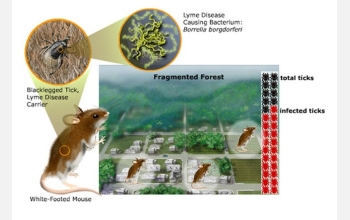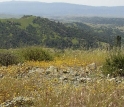News Release 05-176
NSF, NIH Award Ecology of Infectious Diseases Grants
Agencies support studies of environment and disease transmission

Lyme disease transmission is related to forest ecology.
October 4, 2005
This material is available primarily for archival purposes. Telephone numbers or other contact information may be out of date; please see current contact information at media contacts.
The National Science Foundation (NSF) and the National Institutes of Health (NIH) have announced funding for eight projects under the Ecology of Infectious Diseases (EID) Program, multi-year effort now in its the sixth year of funding.The joint NSF-NIH program supports efforts to create a predictive understanding of the ecological and biological mechanisms that govern relationships among human-induced environmental changes and the emergence and transmission of infectious diseases.
Interdisciplinary projects funded through the EID program will study how large-scale environmental events--such as habitat destruction, biological invasion and pollution--alter the risks of viral, parasitic and bacterial diseases emerging in humans and animals. These studies will allow public-health officials, wildlife managers and farmers to control the spread of diseases among humans, domestic and wild animals, and crops, say EID scientists.
"The role of biological diversity and habitat structure in stabilizing communities of plants, animals and microorganisms has received a great deal of attention from ecologists in recent years," said Sam Scheiner, EID program director at NSF. "As a result, our capacity to analyze and model biocomplexity and ecological dynamics, and to evaluate spatial and temporal aspects of environmental change, have become increasingly sophisticated. However, few of these advances in the ecological sciences have yet contributed to biomedical research or to public health. That's where the joint NSF-NIH EID program comes in."
Over the past 20 years, unprecedented rates of change in non-human biodiversity have coincided with the emergence and re-emergence of numerous infectious diseases around the world. The coincidence of broad-scale environmental changes and the emergence of infectious diseases may point to underlying and predictable ecological relationships. Yet both basic and applied research in infectious disease ecology have been largely piecemeal, said Scheiner.
The potential benefits of the EID program include development of disease transmission theory; improved understanding of unintended health effects of development projects; increased capacity to forecast outbreaks; and improved understanding of how diseases emerge and re-emerge.
Previous research looked at diseases only after they had reached humans, or only at non-human animals, said EID program directors at NSF and NIH. The EID program links those different components to produce a comprehensive understanding of disease transmission.
The need for understanding is being driven by the increased pace of global climate change, society's greater global mobility and the threat of the deliberate release of disease organisms, scientists say. By knowing how natural systems work, public health officials can recognize when an outbreak is unnatural. The recent outbreaks of Lyme disease, West Nile virus and SARS show how little is known about the ecology of infectious diseases, said Scheiner.
This year's EID awards include studies of
- the yellow dwarf virus, one of the most economically important diseases of grass crops worldwide;
- the newly introduced soybean rust disease, a threat to soybean fields
- the pathogen responsible for widespread sudden oak death in Calif., which in turn is affecting rates of Lyme disease there
- a pathogen transmitted from the land-based domestic cat to threatened sea otters
- the prevalence of microparasites in cats and rats in an urban environment
- seasonal parasite transmission in mice
- and a human skin disease called Buruli ulcer, a serious disease throughout the tropics that may result from human changes to the landscape, via aquatic invertebrates that bite humans and that live in slow-flowing or stagnating aquatic habitats
-NSF-
-
EID scientists are studying infectious disease transmission in California sea otters.
Credit and Larger Version -
Barley yellow dwarf virus infects many native and introduced grasses.
Credit and Larger Version
Media Contacts
Cheryl Dybas, NSF, (703) 292-7734, email: cdybas@nsf.gov
John Makulowich, NIH, (301) 402-8614, email: makulowj@od.nih.gov
Related Websites
NSF Ecology of Infectious Diseases Program: http://www.nsf.gov/funding/pgm_summ.jsp?pims_id=5269&org=EF
NIH Ecology of Infectious Diseases Initiative: http://www.fic.nih.gov/programs/ecology.html
The U.S. National Science Foundation propels the nation forward by advancing fundamental research in all fields of science and engineering. NSF supports research and people by providing facilities, instruments and funding to support their ingenuity and sustain the U.S. as a global leader in research and innovation. With a fiscal year 2023 budget of $9.5 billion, NSF funds reach all 50 states through grants to nearly 2,000 colleges, universities and institutions. Each year, NSF receives more than 40,000 competitive proposals and makes about 11,000 new awards. Those awards include support for cooperative research with industry, Arctic and Antarctic research and operations, and U.S. participation in international scientific efforts.
Connect with us online
NSF website: nsf.gov
NSF News: nsf.gov/news
For News Media: nsf.gov/news/newsroom
Statistics: nsf.gov/statistics/
Awards database: nsf.gov/awardsearch/
Follow us on social
Twitter: twitter.com/NSF
Facebook: facebook.com/US.NSF
Instagram: instagram.com/nsfgov




